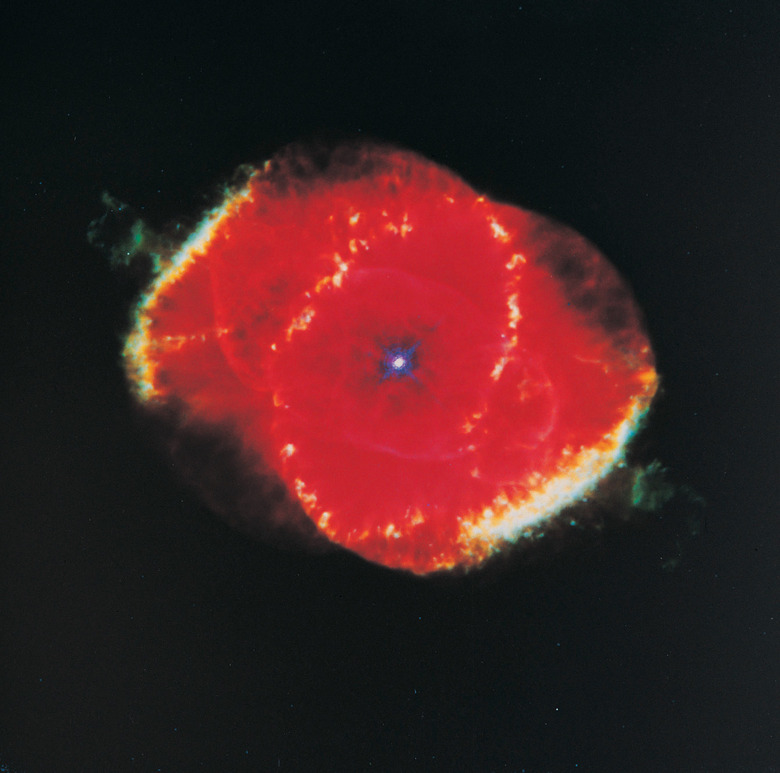What Are The Final Stages In The Life Of A Star Similar In Size To The Sun?
To understand what happens at the end of the life of a star similar to the sun, it helps to understand how stars form in the first place and how they shine. The sun is an average-sized star and, unlike a giant like Eta Carinae, won't go out as a supernova and leave a black hole in its wake. Instead, the sun will become a white dwarf and simply fade away.
Star Formation and Main Sequence
Star Formation and Main Sequence
Stars are born from intergalactic dust. As a cloud filled with dust and hydrogen and helium gas slowly begins to revolve around a central core, the core attracts more matter, and the increasing pressure heats it up until it becomes hot enough for the hydrogen gas to fuse in a nuclear reaction. The energy generated by the fusion reactions prevents further collapse, and the core becomes a main sequence star. Massive stars use their hydrogen fuel quickly and can burn out in as few as 3 million years. The main sequence of a star similar to the sun, however, is about 10 billion years.
The Red Giant Phase
The Red Giant Phase
When a sun-sized star uses up the hydrogen in its core, fusion stops, and the temperature isn't high enough for helium fusion to begin. The lack of outward radiation pressure allows the core to contract. Because the core is contracting and the gravitational attraction weakening, the outer layer cools, turns red and starts to expand, and the star turns into a red giant. Red giants typically grow to 10 to 100 times the diameter of the main sequence star. When the sun enters its red giant phase, which will last from 1 to 2 billion years, it could grow large enough to engulf the Earth.
The Second Red Giant Phase
The Second Red Giant Phase
As the core of a red giant contracts, electrons are packed so closely together that quantum mechanical principles become important. The Pauli Exclusion Principle dictates that no two electrons can occupy the same state, and the forces of repulsion become become stronger than thermal pressure and independent of temperature. Matter in this state is said to be degenerate, and it allows explosive reactions to occur. Helium in the core begins to fuse into carbon while the hydrogen in the layer surrounding the core also begins to fuse into helium. These reactions produce more outward pressure, causing the star to expand even more. This is the second red giant phase, and it lasts for about a million years.
The White Dwarf Phase
The White Dwarf Phase
The core of a red giant eventually reaches a point at which, due to quantum mechanical principles, it can no longer collapse, and it begins to burn with a bluish white light, becoming a white dwarf. By this time, its mass is similar to that of the original star, but its diameter is about the size of the Earth, so it is super-dense. It eventually cools, turns into a black dwarf and goes dark. While it is still a white dwarf, the gases forming the outer layer of the star cool and drift away from the core in a formation known as a planetary nebula. Well-known examples include the Ring and Cat's Eye Nebulae.
Cite This Article
MLA
Deziel, Chris. "What Are The Final Stages In The Life Of A Star Similar In Size To The Sun?" sciencing.com, https://www.sciencing.com/what-are-the-final-stages-in-the-life-of-a-star-similar-in-size-to-the-sun-12730976/. 2 December 2013.
APA
Deziel, Chris. (2013, December 2). What Are The Final Stages In The Life Of A Star Similar In Size To The Sun?. sciencing.com. Retrieved from https://www.sciencing.com/what-are-the-final-stages-in-the-life-of-a-star-similar-in-size-to-the-sun-12730976/
Chicago
Deziel, Chris. What Are The Final Stages In The Life Of A Star Similar In Size To The Sun? last modified March 24, 2022. https://www.sciencing.com/what-are-the-final-stages-in-the-life-of-a-star-similar-in-size-to-the-sun-12730976/
